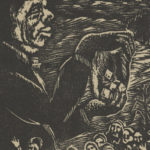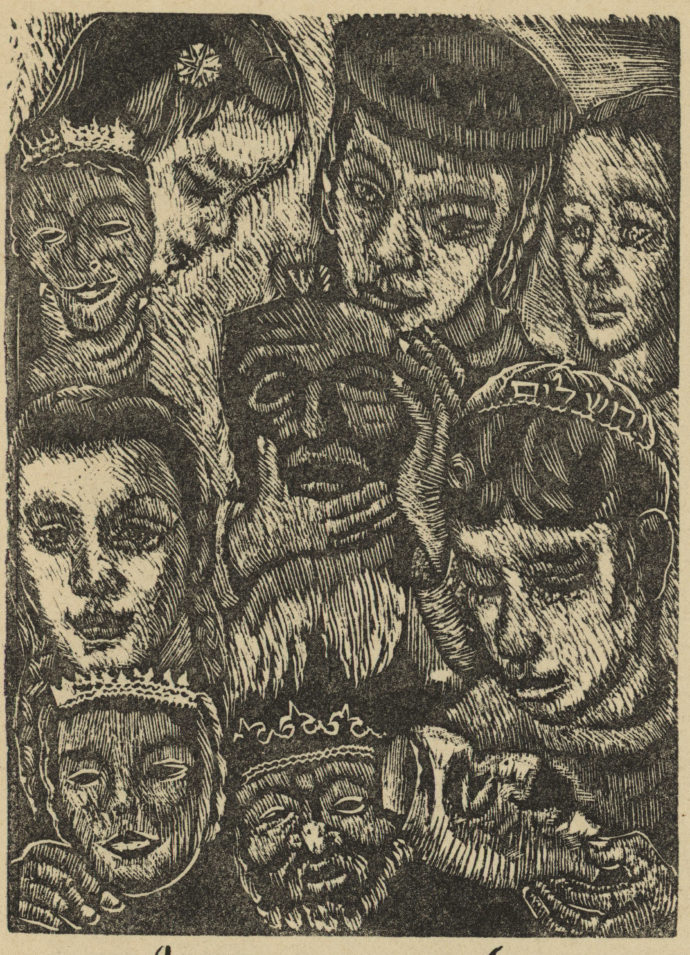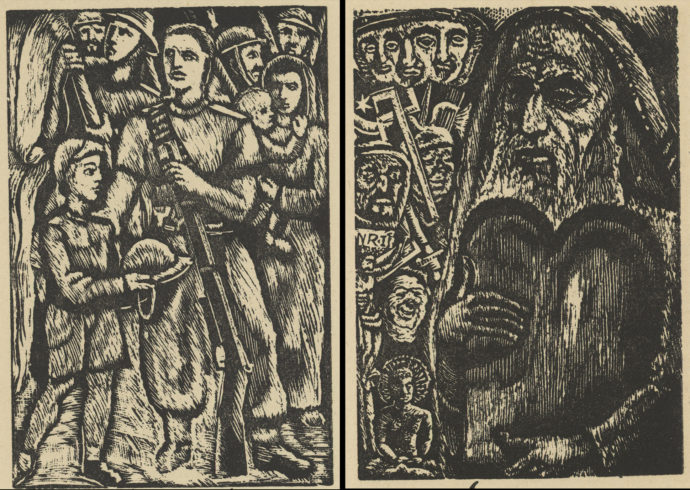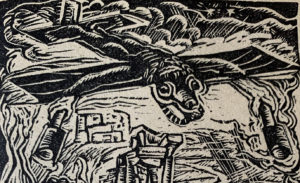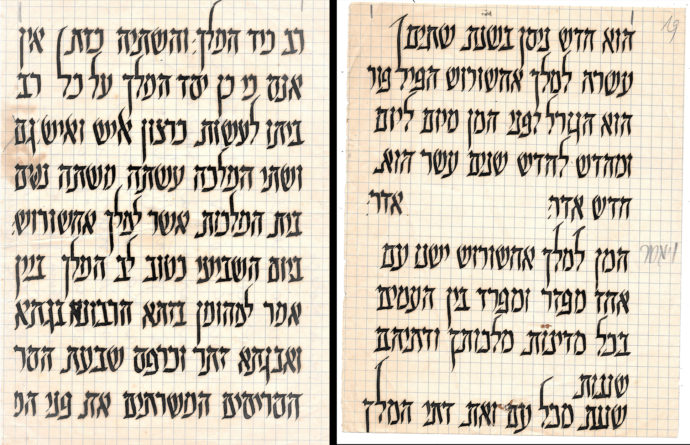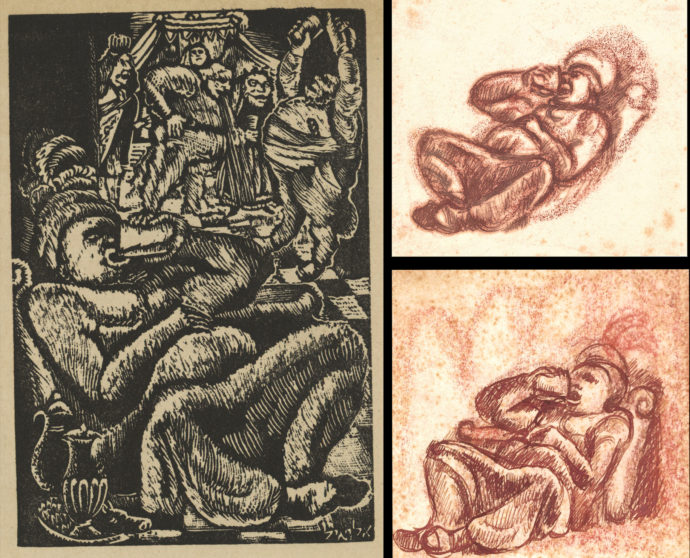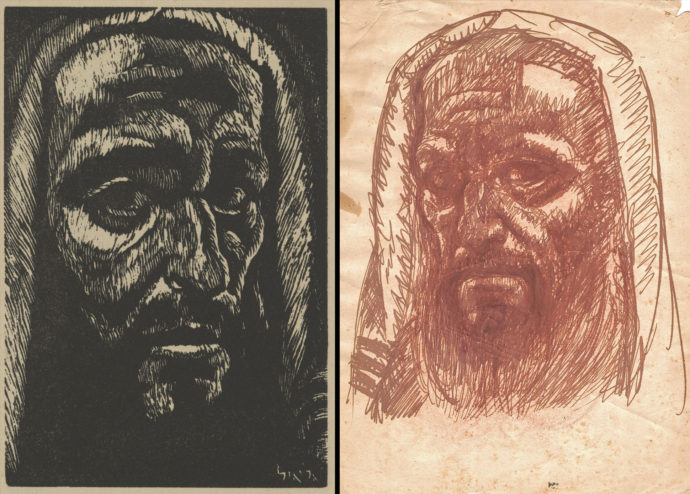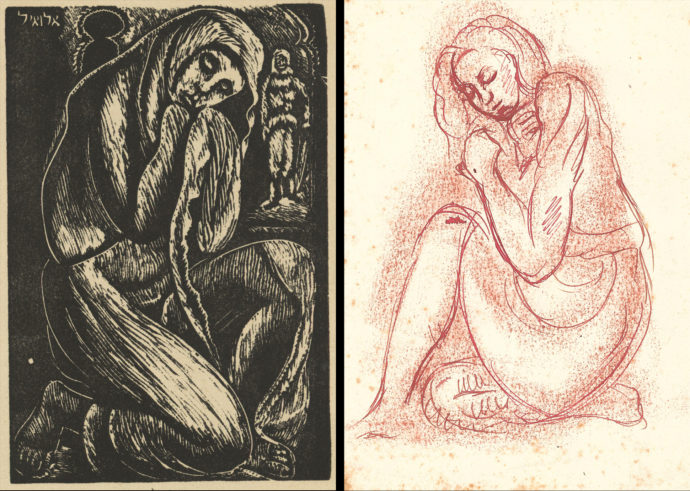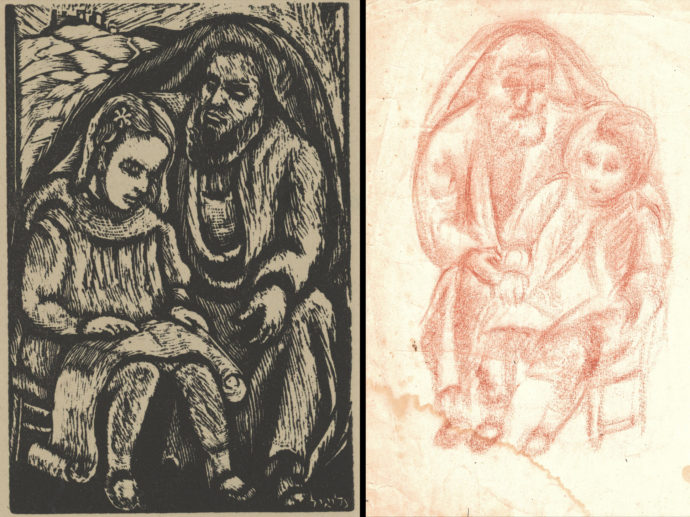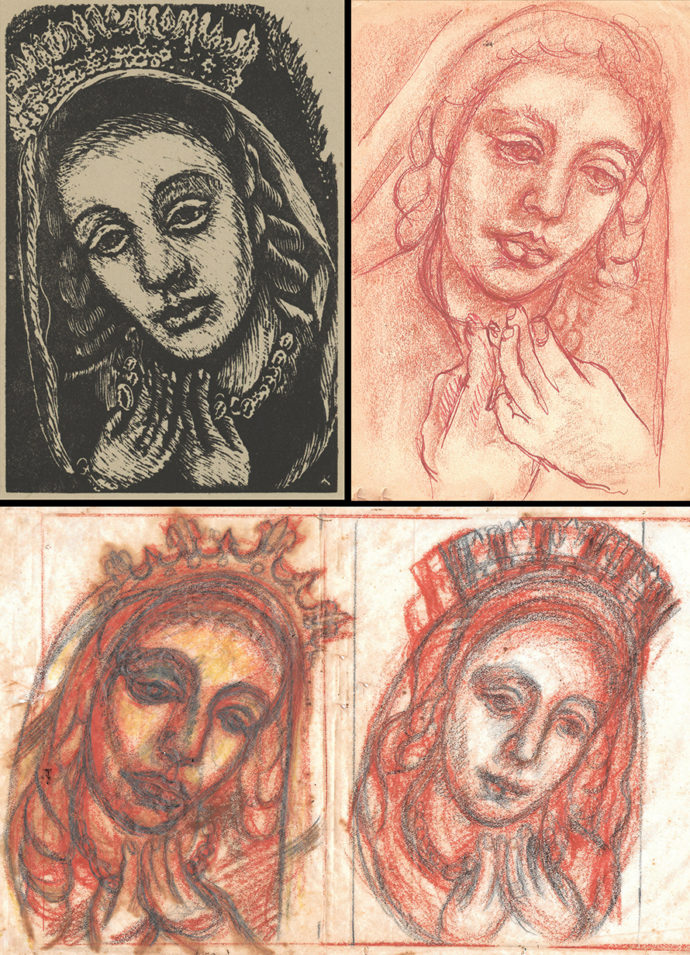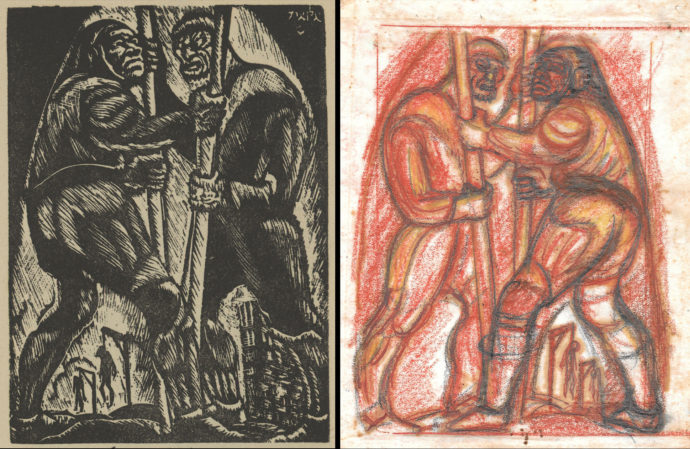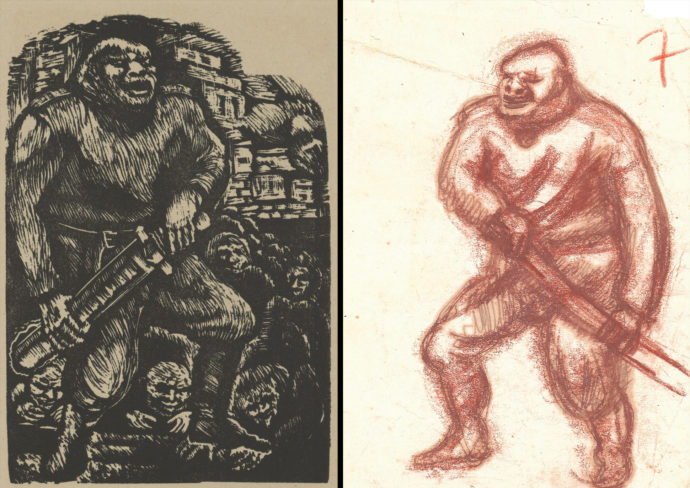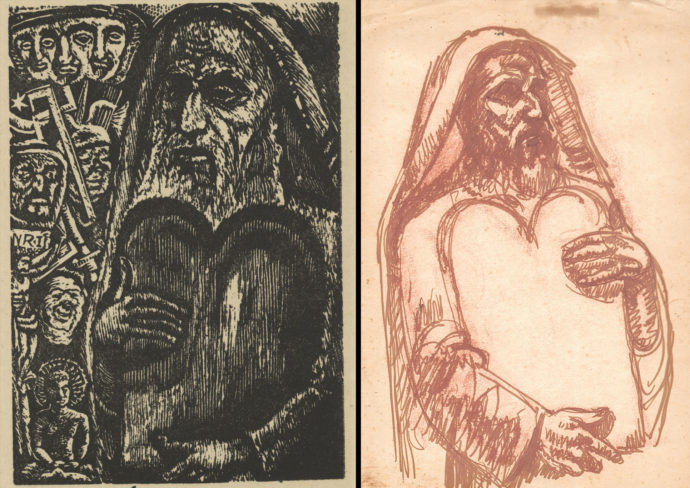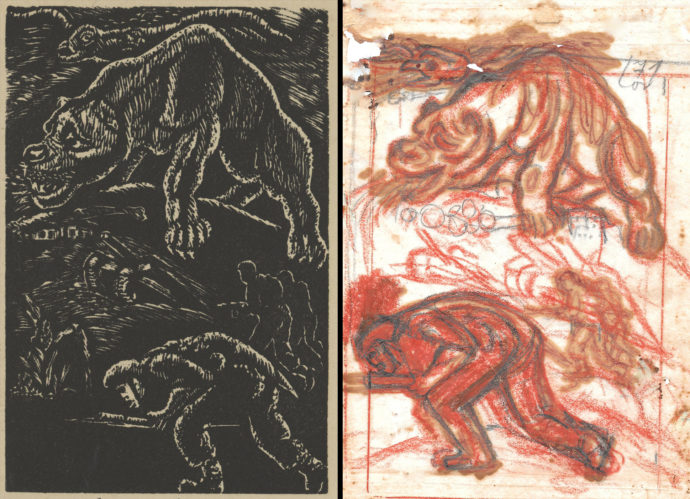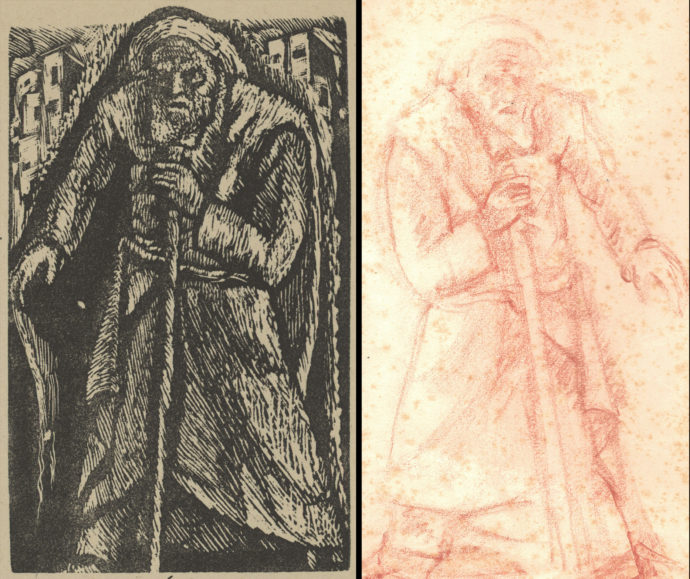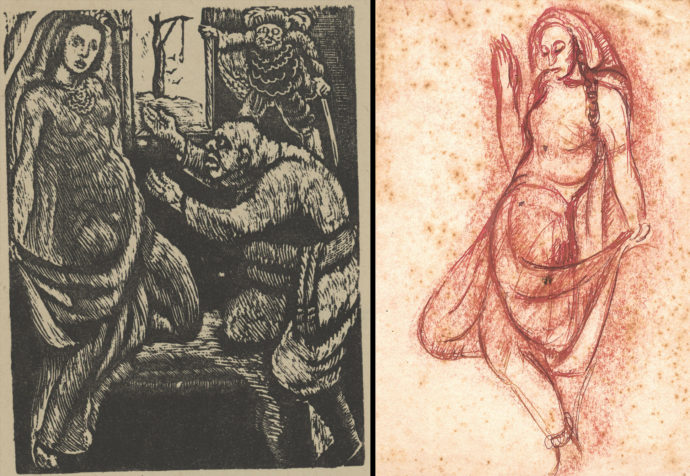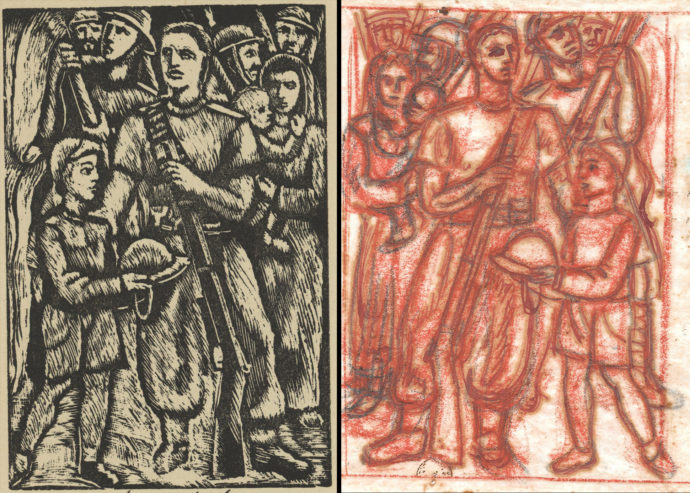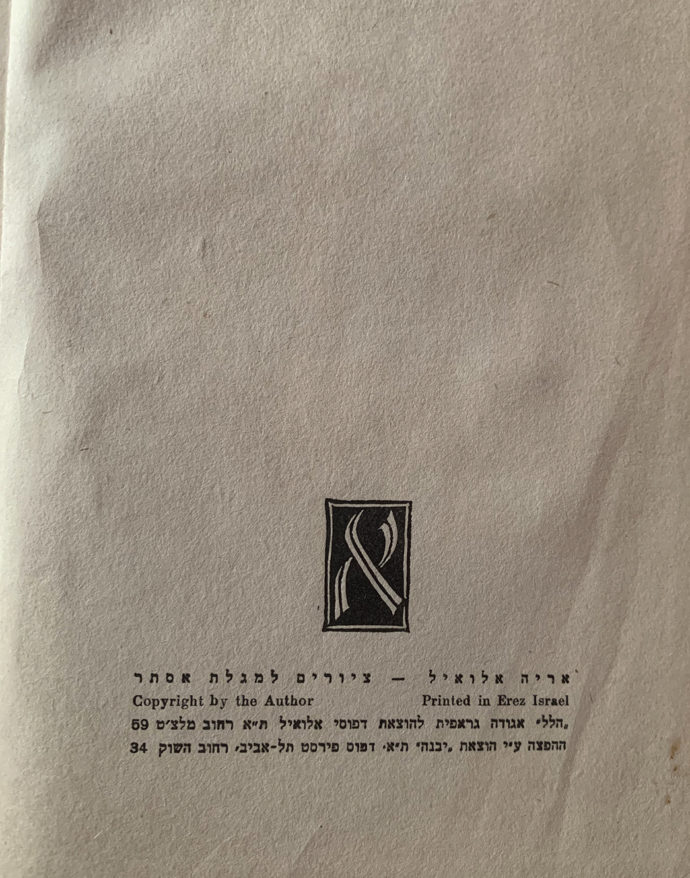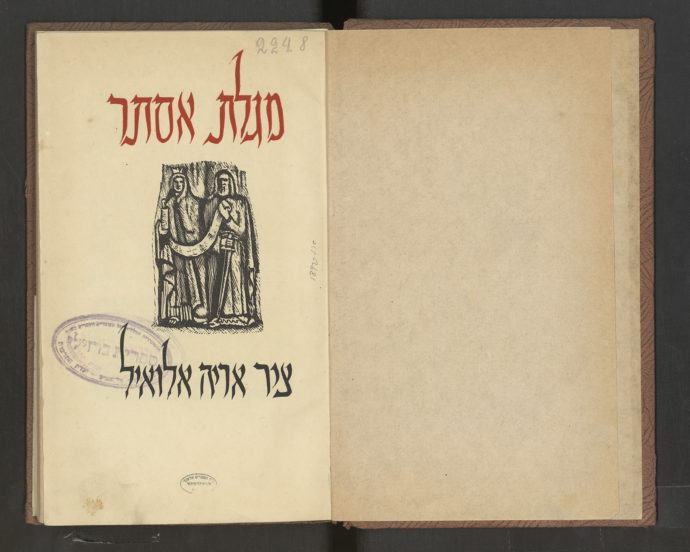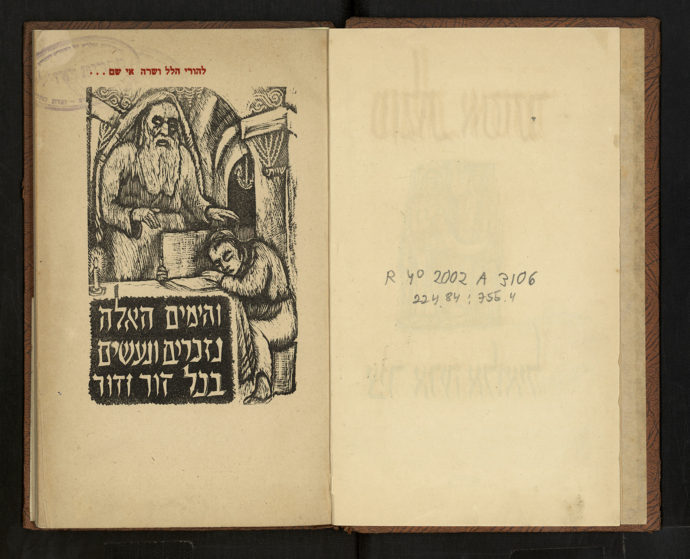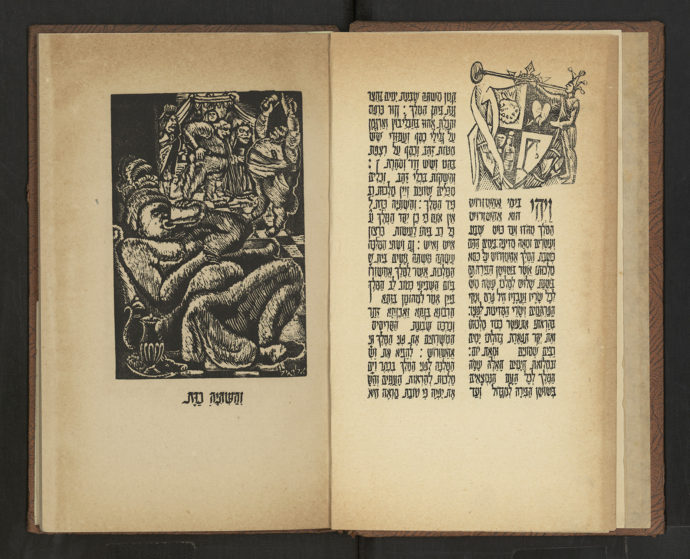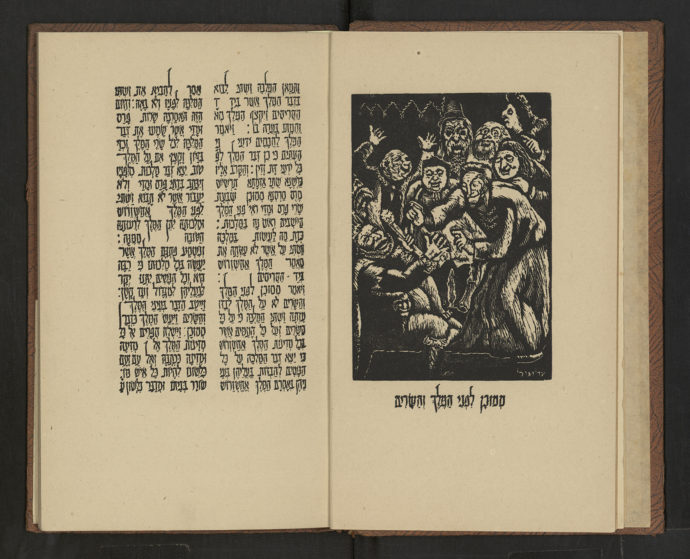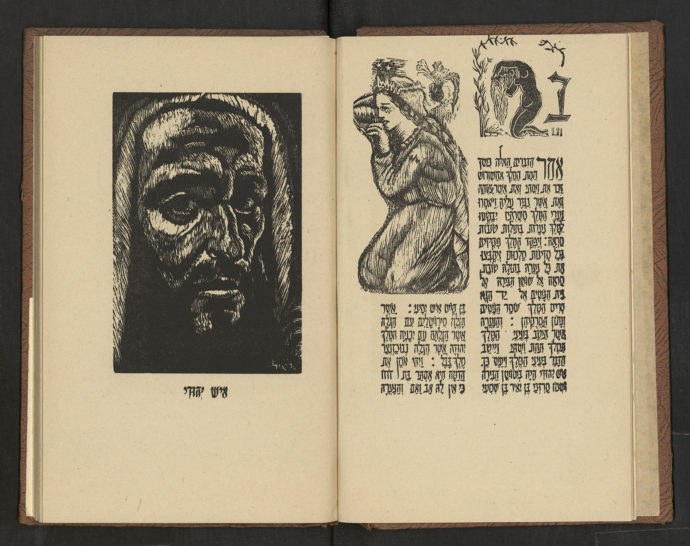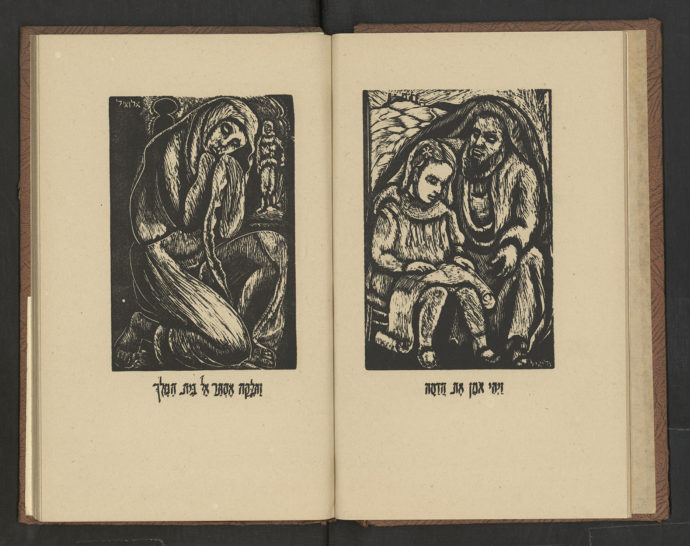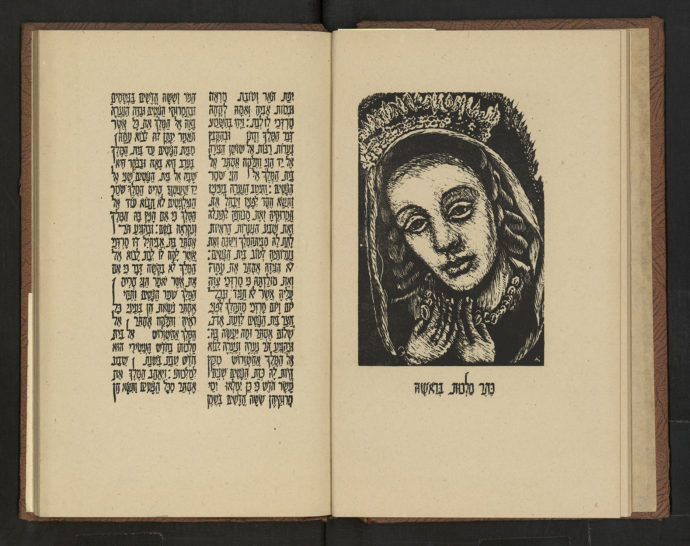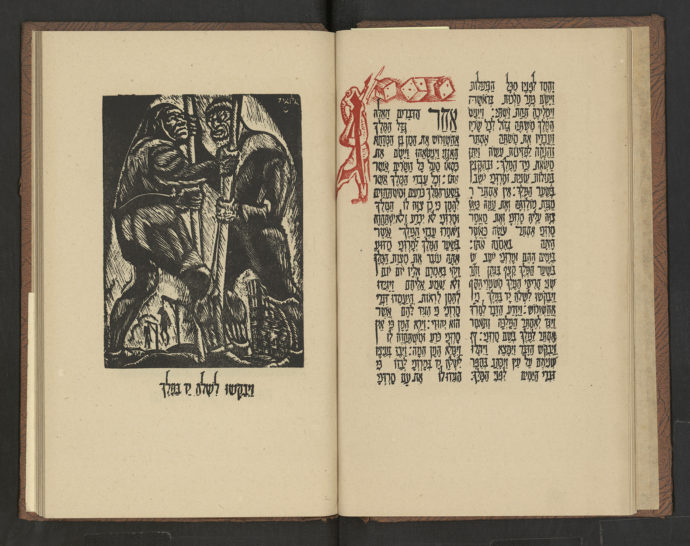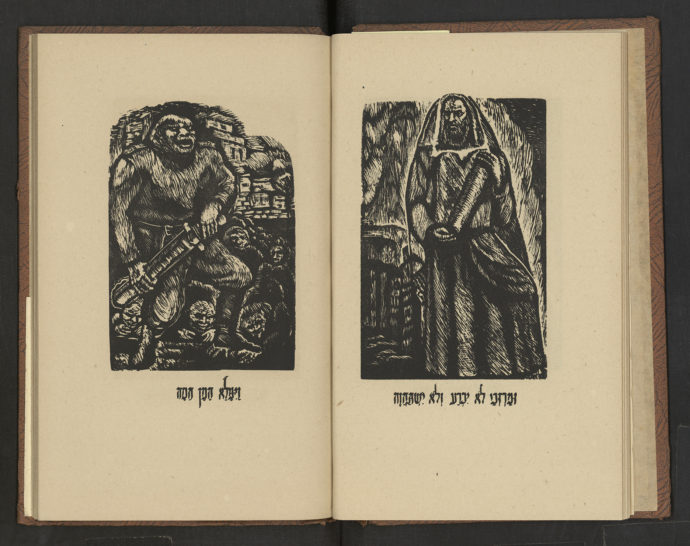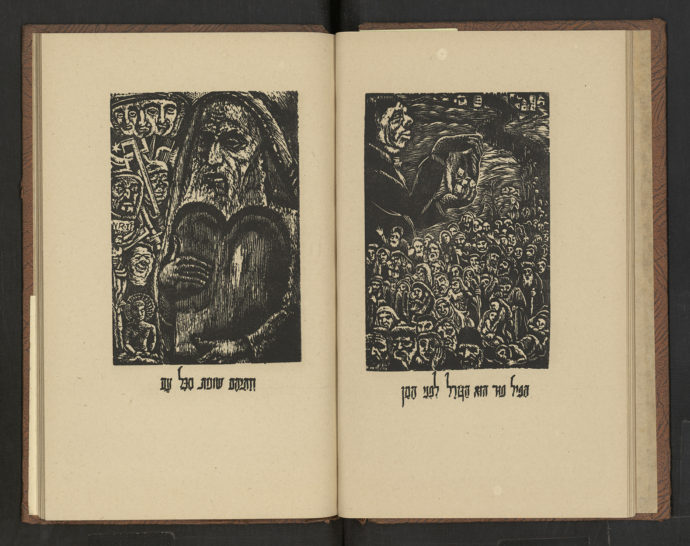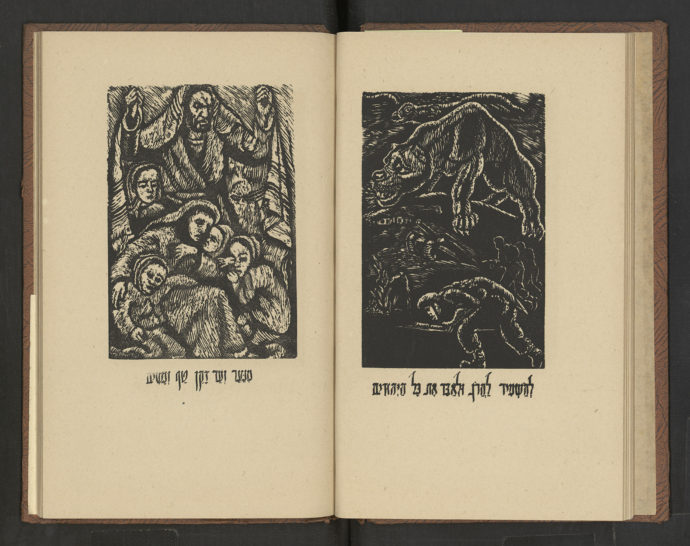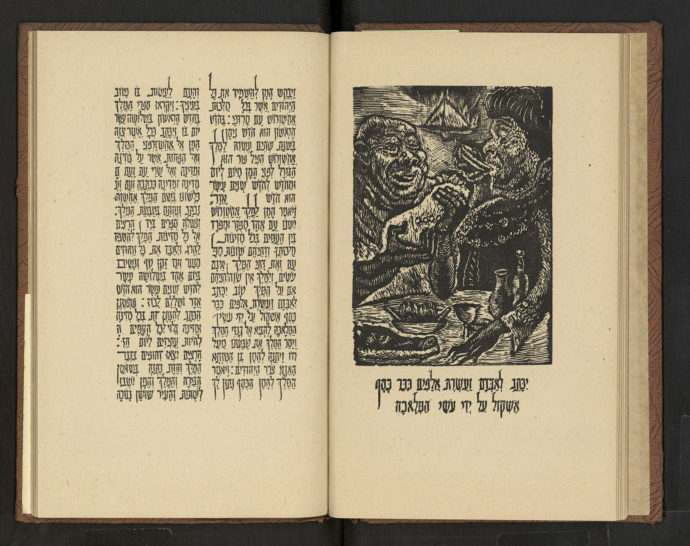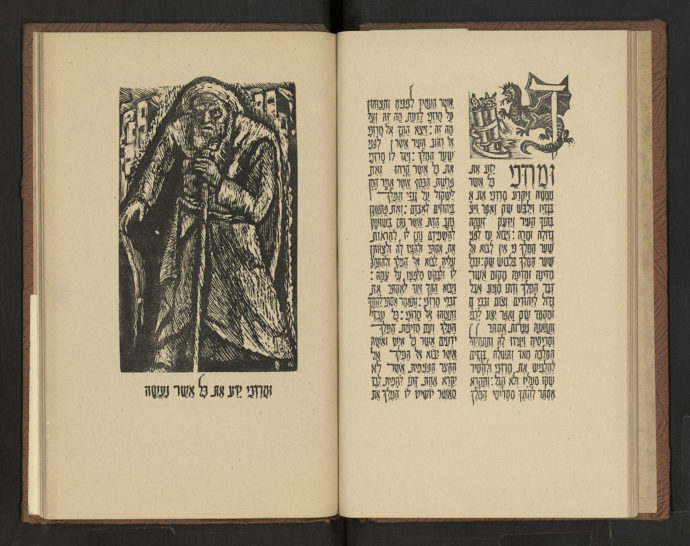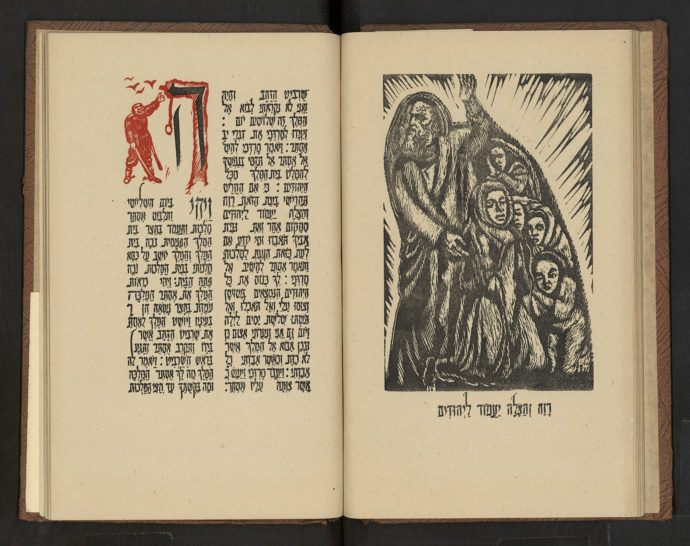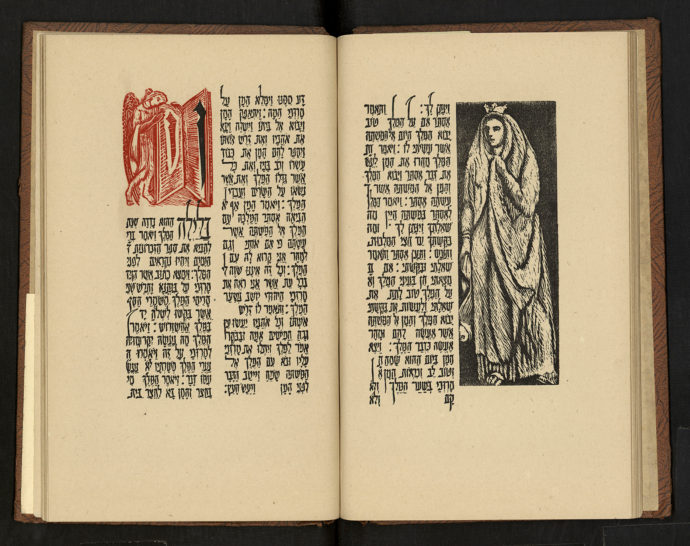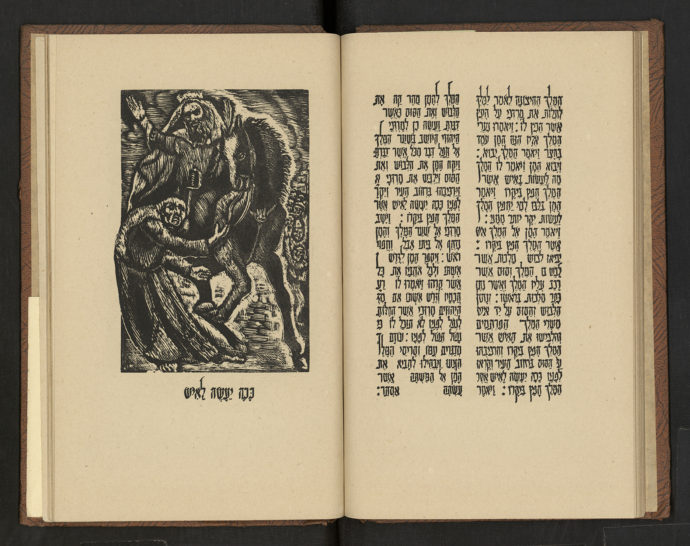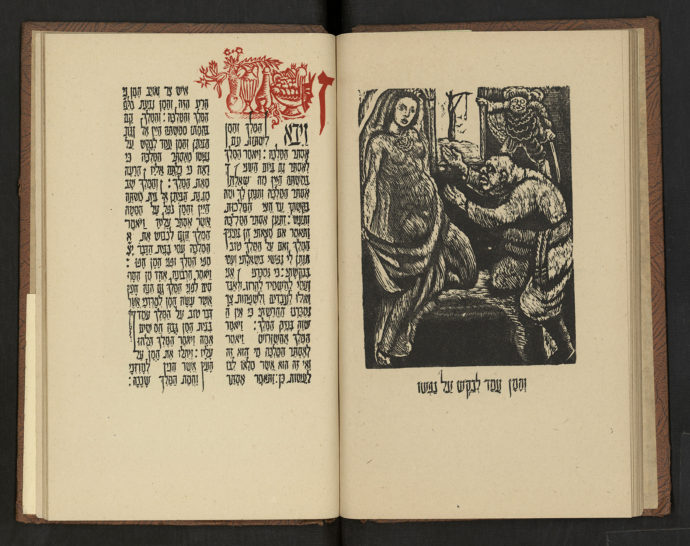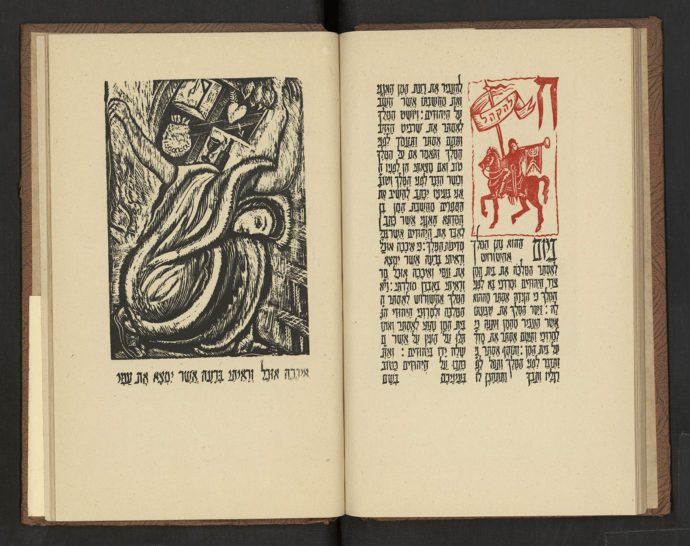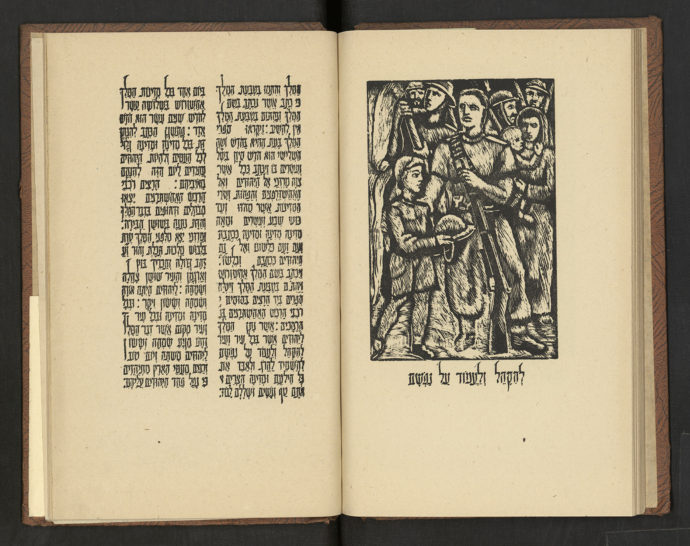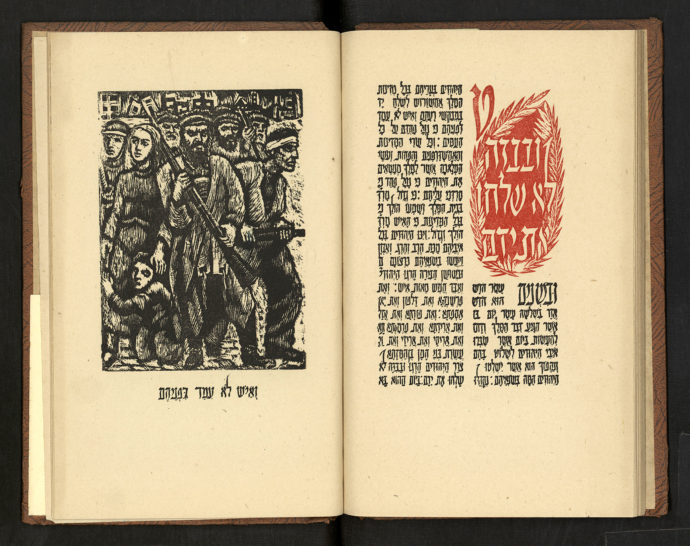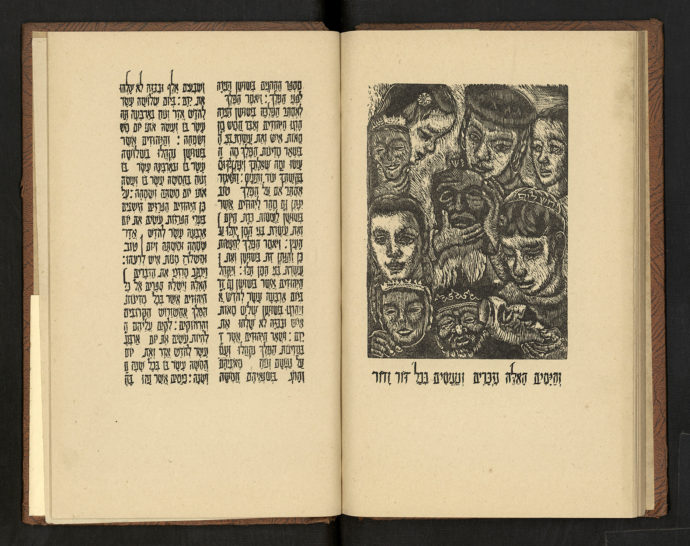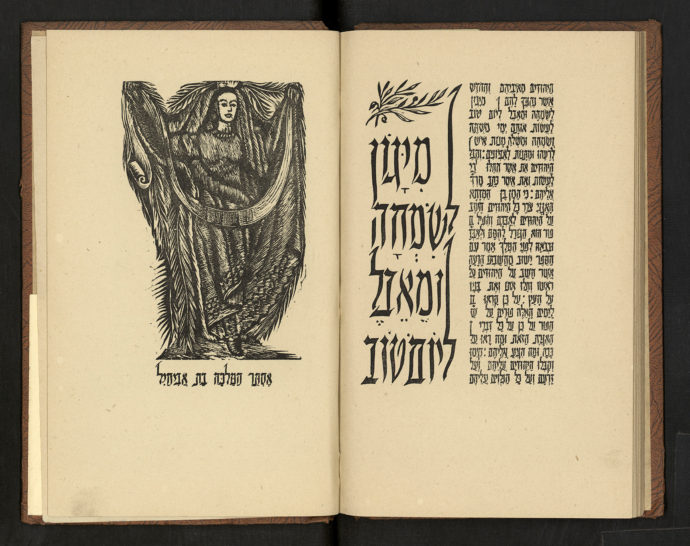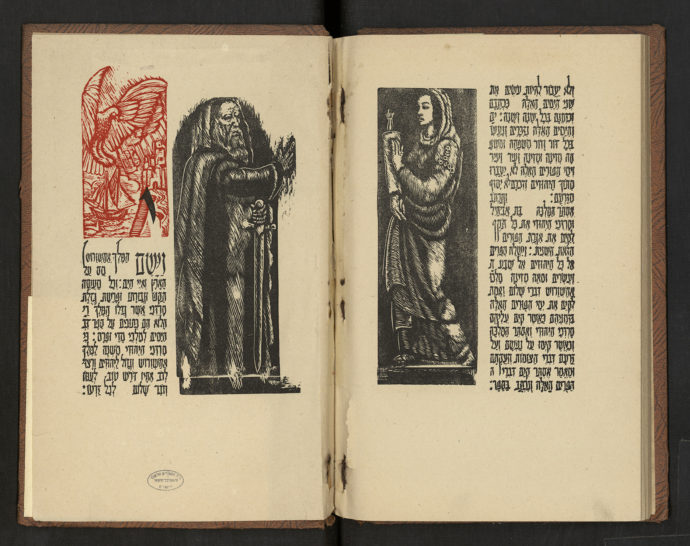Arieh Allweil: Scroll of Esther
Introduction
If only I had a better sense of timing!
If I did, I wouldn’t be blogging on artist Arieh Allweil’s Scroll of Esther now (Autumn of 2021). I would have posted it to coincide with the festival of Purim, which this year occurred in February (on the 14th day of the Hebrew month of Adar).
The word “Purim” is integral to the story of Esther. It means “lots,” as in the “casting of lots.” In the detail (left) from one of the linocuts in Allweil’s Scroll of Esther, the villain in the story–Haman–is about to cast “Pur” to decide the fate of Jews, a decisive moment on the story of Esther.
Here’s a brief synopsis of Esther courtesy of Wikipedia:
The Scroll of Esther is one of the five scrolls (megillahs) in the “scriptures” section of the Bible. It tells of a plot by Haman to exterminate the Jews of the kingdom of Persia in the days of King Ahasuerus, and how it was thwarted by Queen Esther and her cousin Mordecai The Jew.
Each year at Purim the Biblical account of Esther is retold often with Jewish children donning masks of the principal characters: Esther, Mordecai, Haman and Ahasuerus. The above image appears in toward the end of Allweil’s Scroll of Esther.
The Galicia-born Arieh Allweil (1901-1967) was living in Eretz Israel (Mandatory Palestine) when he created an impressive series of books that he illustrated with linocuts. Some were essentially picture books (Anonymous Jew and A Tour of the Land). And some told megillahs with linocuts and text. The first was Ruth (1939); the second was Amos (1940). Esther was next in 1942.
Perhaps, wrote daughter Ruth Sperling in an email, Allweil chose to published the Scroll of Esther in 1942 because World War II was raging and European Jews were suffering terribly (although the extent of the Holocaust was not imagined by most). With Esther as an account of an attempt to slaughter Jews in Biblical times, Sperling wrote: “The plan ‘to destroy, to kill, and to cause to perish all Jews…’ (Esther 3/13) gives the ancient stories 20th-century significance.”
Visually Allweil made that connection by stepping out of the Old Testament in some of his linocuts. The Esther image on the right carries the caption: “And their laws are diverse from all people” (Esther 3/8). To illustrate “all people” Allweil chose to depict all religions, giving dominance to Moses holding the Ten Commandments. At the lower left sits Buddha, and above Buddha is a crucified Christ. Regarding the other small figures to the left of Moses, Allweil’s other daughter Nava Rosenfeld wrote: “The face above Jesus is the face of an Arab. He is holding a kind of sword and above his head is a kind of a moon and a star. So he is a Moslem. The face above the Buddha looks to me like the face of a happy priest. Look at his collar.” She also thinks that above the priest is another priest “holding a stick which turns to a cross that turns to a swastika.” As to the top-most three faces that share four eyes, Sperling remarked: “They reminded us of ancient Greek masks, especially the Mycenae masks.”
The Esther linocut on the left has the caption: “To gather themselves together and to stand for their life” (Esther 8/11). Here Allweil depicted a rifle and contemporary helmets to bring the lessons of Esther into the 20th century.
Allweil also interjected modern imagery–an airplane and a tank for instance–in his 1939 book Amos. (LINK) As Sperling said his books give “the ancient stories 20th-century significance.” This is what excited me when I first thumbed through my copy of Amos, the first of Allweil’s books to enter my collection.
This post is the eighth ART I SEE post on the works of Arieh Allweil, and it is the fourth post devoted to a megillah from the Hebrew Bible. Previously ART I SEE devoted posts to two megillahs initially published in 1939, namely Amos and Ruth. (Links to all previous Allweil posts can be found at the conclusion of this post. For a bio of the artist and a snapshot of each of his books including one portfolio, go to the first Allweil post: LINK) Except for his 1924 lithographic portfolio Tura Afura which he created while studying art in Vienna, all of his publications covered by ART I SEE were made while he lived in Eretz Israel between 1939 and 1944.
None of the posts on Arieh Allweil would have been possible without the tireless efforts of Ruth Sperling, Professor of Genetics at the Hebrew University of Jerusalem, and Nava Rosenfeld, a retired architect.
Scroll of Esther and its contents as well as preparatory drawings and calligraphy are presented courtesy of the Estate of Arieh Allweil.
Production of Esther
Both the text and images in Allweil’s Scroll of Esther are works of art, but they were produced two different ways. The images were made via the centuries-old medium of relief printmaking. In the case of Esther, Allweil hand cut his images into blocks of linoleum, a very economical way of making a relief print. The linocuts in Esther were printed directly from the blocks.
The text pages also began with the artist’s hand when he used pen and ink to produced elegant lines of Hebrew. The two pages shown above are examples of his calligraphy, similar to what he did in preparation for his Esther.
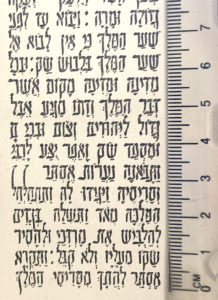 In order to better understand Allweil’s working methods, I wanted to know the size of the squares on the graph paper. Rosenfeld measured it and reported that each square measures 5 mm high. The letters–ignoring Allweil’s dramatic ascenders and descenders–are somewhat taller than two squares on the graph paper. Let’s say each is 12 mm high or 1.2 cm. A quick measure of the text (right) in Esther shows that his calligraphy was reduced to about 4 mm high, or 33% of the original.
In order to better understand Allweil’s working methods, I wanted to know the size of the squares on the graph paper. Rosenfeld measured it and reported that each square measures 5 mm high. The letters–ignoring Allweil’s dramatic ascenders and descenders–are somewhat taller than two squares on the graph paper. Let’s say each is 12 mm high or 1.2 cm. A quick measure of the text (right) in Esther shows that his calligraphy was reduced to about 4 mm high, or 33% of the original.
When he was satisfied with any given page, it was photographed. (The grid in blue would not be picked up by the photographic exposure.) The cameraman would also scale the text block to fit the page. The text blocks in Esther average about 14 cm high (about 5 1/2″) and each column of text is 3.9 cm wide (about 1 1/2″). This process allowed Allweil to write his text at a more comfortable size, as illustrated by his calligraphy on graph paper. The resulting transparency (film) would then be used to make a stereotype for casting the text block in lead.
Creating the linocuts also required much preparatory work as it is not easy to recreate the original surface of linoleum once the artist mistakenly has cut a piece of it away. In short he needs to know exactly where he wants to make a cut. Hence, preparatory drawings. Allweil used pen and ink and chalk (usually a sanguine-colored piece) on paper. He also drew on translucent pergament paper (also known as parchment) when he was satisfied with his image and was ready to transfer the image onto a linoleum block. “About the pergament paper,” Rosenfeld wrote, “as a student of architecture in the Sixties we used to draw on a pergament paper whose weight was 90 grams. So I recognize the paper my father used…. He would pin the paper and then turn it. He probably then marked the linoleum through the holes. We did have some [linoleum] with marks for another book. That is how we understood it.”
The Allweil daughters sent drawings on paper and on pergament related to Esther. The following are thirteen pairings of Esther linoleum cuts with associated drawing(s). The drawings are on paper except where pergament is indicated. They are presented in the order the linoleum cuts appear in the book.
Scroll of Esther: 10 chapters
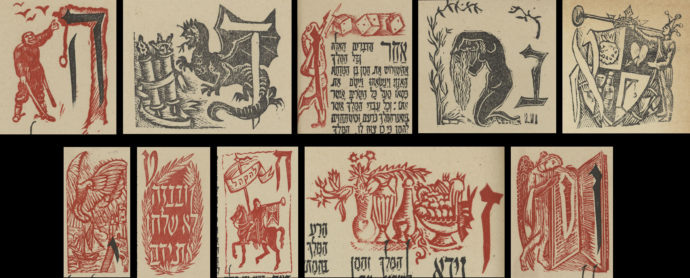
The ten historiated initials in the “Scroll of Esther” shown as they occur in the book. The sequence reads from right-to-left, the top line then the bottom line. (The images are not to scale)
Allweil introduced each of the ten chapters of the Scroll of Esther with an historiated initial, i.e. a large letter accompanied by a pictorial design. In most cases when the historiated initials are used, the large letter is the first letter in the first word of the text. But in this case Allweil letters are the first 10 letters in the Hebrew alphabet. The sequence (R-to-L) top line then bottom line:
ה hay, ד daled, ג gimel, בּ beit, א aleph
י yud, ט tet, ח khet, ז zayin, ו vav
Scroll of Esther: The cover
Sperling described the elements on the cover: “[On the left] it has a sword and an olive leaf combined, in view of the fact that the Jews were allowed to protect themselves and the peace that followed.” The large letters are the title: Scroll of Esther. Above the title, she wrote, “he has written the word להקהל, which means “to gather.” This is the beginning of the sentence: ‘To gather themselves together and to stand for their life.’ For our father this was the moral of Esther, together with the sentence: ‘But on the prey that laid not their hands,’ echoing the reality of the time our father created Scroll of Esther.” The bottom line reads: Painter Ariel Allweil.
Scroll of Esther: Page by Page
Apparently there were two printings of Allweil’s Scroll of Esther with only slight differences. In my initial post on Arieh Allweil and his books (See LINK), only one edition, in 1942, is listed. But in preparing for this post Ruth Sperling and I realized this edition had some variations. The copy presented below was scanned by the National Library of Israel. It differs from the copies that both Sperling and I have in that 1) a colophon is missing opposition the book’s first full page linocut and 2) on the first page of text the shield beside the Hebrew letter Alef (א) is black and not red.
Here is the colophon as it appears in Sperling’s and my copies:
Arieh Allweil – Paintings for the Scroll of Esther
Copyright by the Author. Printed in Eretz Israel.
“Hillel” graphic organization to print Allweil’s graphic art. Tel Aviv, 59 Melchet St.
Distribution by “Yavneh” Tel Aviv, printing by First Tel Aviv, 34 Hashomer St.
The National Library scans do not include the cover, presumably because that copy had been recovered. The image above of the cover is the cover on my copy.
As noted in previous posts on Allweil and his works, the Hebrew word that translates as “painter” is essentially synonymous with “artist.” And as in the colophon the use of the word for “paintings” should be read was “artworks.” In this case the “artworks” are linocuts and calligraphy
Underneath the translations of the captions is a synopsis of the text, where Nava Rosenfled has woven the captions into the narrative of Esther.
Painter Arieh Allweil
… to my parents Hillel and Sarah somewhere
And that these days should be remembered and kept throughout every generation (Esther 9/28)
(From Ruth Sperling regarding the dedication to the parents: “These were horrible days, with no communication with his parents, not knowing where they are and what happened to them, and still hoping they might have been saved.” The last time he visited them in Galicia was 1936.)
And the drinking was according to the law; none did compel (Esther 1/8)
The scroll starts with a grand banquet, lasting 187 days showing the wealth and grandeur of King Ahasuerus. “And the drinking was according to the law.” The king invites Vashti, his wife, to come to the ball.
Memuchan before the king and the captains (Esther 1/16)
When she refuses, “Memuchan before the king and the captains” advises the king to send her away. After that the king wanted a new wife.
A certain Jew (Esther 2/5)
There was “a certain Jew” in Shushan, the capital of Persia, whose name was Mordecai.
(Right) And he brought up Hadassah (that is: Esther) (Esther 2/7)
(Left) Esther was brought also unto the king’s house (Esther 2/8)
“And he brought up Hadassah, that is Esther.” “Esther was brought also unto the king’s house,” and was chosen to be the queen.
The royal crown upon her head (Esther 2/17)
And sought to lay hand on the king (Esther 2/21)
After that, Mordecai heard that two of the king’s guards “sought to lay hand on the king.” Mordecai told Esther and she told the king about that plot.
(Right) But Mordecai bowed not; nor did him reverence (Esther 3/2)
(Left) Then was Haman full of wrath (Esther 3/5)
There was a man called Haman, whom the king exalted. All the courtiers bowed to him, “but Mordecai bowed not, nor did him reverence… Then was Haman full of wrath….” and he decided to kill not just Mordecai, but all the Jews in the kingdom.
(Right) They cast Pur (that is the lot) before Haman (Esther 3/7)
(Left) And their laws are diverse from all people (Esther 3/8)
“They cast Pur (that is the lot) before Haman.” Haman told the king about the Jews, that “their laws are diverse from all people” and they should be exterminated.
(Right) To destroy, to kill, and to cause to perish all Jews (Esther 3/13)
(Left) Both young and old, little children and women (Esther 3/13)
Messages were sent to all the King’s provinces “to destroy, to kill, and to cause perish all Jews.” “Both young and old, little children and women….”
Let to be written that they may be destroyed; and I will pay ten thousand talents of silver to the hands of those that are in charge of the business (Esther 3/9)
And Mordecai perceived all that was done (Esther 4/1)
“And Mordecai perceived all that was done….” He turned to Esther and told her to go to the king and plead for her people.
Then shall there enlargement and deliverance arise to the Jews (Esther 5/14)
He said, if she does not do it, “then shall there enlargement and deliverance arise to the Jews” from another source.
Esther invited the king to come to her chambers with Haman.
Thus shall it be done to the man whom the king delights to honor (Esther 6/9)
Meanwhile, the king was told that Mordecai saved his life before. The king wishes to thank Mordecai, and he seeks Haman’s advice. “Thus shall it be done to the man whom the king delights to honor..” Haman advises (thinking it refers to himself).
And Haman stood up to make a request for his life (Esther 7/7)
On Esther’s feast, she tells the king about the plot to kill the Jews, and she points at Haman. “And Haman stood up to make request for his life,” but he ends hanging on the tree he prepared for Mordecai.
For how can I endure to see the evil that shall come upon my people? (Esther 8/6)
“How can I endure to see the evil that shall come unto my people,” laments Esther to the king.
To gather themselves together and to stand for their life (Esther 8/11)
The king allowed the Jews “to gather themselves together, and to stand for their life.”
(Right in red) But on the prey they laid not their hands (Esther 9/15)
(Left) And no man could withstand them (Esther 9/2)
“But on the prey they laid not their hand.” And on the day that Haman planned to kill all the Jews, they gathered together and fought. “And no man could withstand them..”
And that these days should be remembered and kept throughout every generation (Esther 9/28)
(Right) From sorrow to joy, and from mourning into a good day (Esther 9/22)
(Left) Esther the queen, the daughter of Abihail (Esther 9/29)
How “from sorrow to joy, and from mourning into a good day…” they saved themselves, with the help of “Esther the queen, the daughter of Abihail”
“For Mordecai the Jew was next unto the King Ahasuerus, and great among the Jews, and accepted of the multitude of his brethren, seeking the wealth of his people, and speaking peace to all his seed.”
PREVIOUS POSTS ON ARIEH ALLWEIL
This post is the eighth on the works of Arieh Allweil. Here are links to the previous seven.
- The first introduced the artist and offered a snapshot of his books (LINK).
- The second was the first of two posts devoted to Allweil’s Book of Amos. It examined his production of text in linoleum cuts. (LINK)
- The third presented all of the linocuts in Amos with translations of captions and much of the text. (LINK)
- The fourth stepped back to his days in Vienna, where he created a portfolio of lithograph entitled Graues Band in German and Tura Afura in Hebrew. (LINK)
- The fifth present his book Anonymous Jew and a translation of the essay by Max Brod. (LINK)
- The sixth covered the book of linocuts called Touring the Land and a translation of its essay by Max Brod. (LINK)
- The seventh covered the 1939 Scroll of Ruth. (LINK)
Comments
To leave a comment. please email me at: p1m1@comcast.net
Trackback URL: https://www.scottponemone.com/arieh-allweil-scroll-of-esther/trackback/

